Overview
The article provides a step-by-step guide on how to use the ‘Include in Report Refresh’ feature in Power BI, which allows users to specify which data sources are updated during a report refresh. This is crucial for maintaining data accuracy and operational efficiency, as the article emphasizes the importance of timely updates and offers best practices to optimize the refresh process while mitigating common issues.
Introduction
In the dynamic landscape of data analytics, the ability to maintain up-to-date and accurate reports is paramount for informed decision-making. Power BI offers a robust framework for report refresh, ensuring that stakeholders have access to the latest insights.
However, navigating the intricacies of data refresh processes can present challenges that, if left unaddressed, may hinder operational efficiency. This article delves into the essential components of report refresh in Power BI, from understanding the mechanics of scheduled updates to troubleshooting common issues.
By exploring best practices and practical solutions, organizations can enhance their reporting capabilities, streamline workflows, and ultimately drive strategic growth through data-driven insights.
Understanding Report Refresh in Power BI
In BI, the report update procedure is vital for ensuring your reports display the most recent information. This step is fundamental to maintaining integrity, as it guarantees that changes in underlying sources are accurately represented in your visualizations. As mjmowle, an advocate for information precision, noted,
With BI Premium, you can establish update schedules as often as every 15 minutes…
emphasizing the flexibility available to users.
However, while up to 48 refreshes can be assigned within a 24-hour period, they remain confined to 30-minute intervals, highlighting the need for strategic scheduling to avoid time-consuming report creation and inconsistencies. Power BI also disables update schedules after four successive failures, highlighting the significance of overseeing update processes to preserve information integrity and offer practical insights. The lack of clear, actionable steps can leave stakeholders uncertain about the next actions, which reduces the significance of the information presented.
The effect of timely data updates on report accuracy cannot be overstated; it directly influences effective data analysis and informed decision-making. Recent updates to the BI tool’s update features, including a history view showing the latest 60 records of scheduled updates, enhance this process further. Moreover, case studies like ‘Example of Refresh Time Slot Analysis’ reveal how overlapping refresh events can occur when one refresh exceeds its designated time slot, prompting administrators to adjust schedules accordingly and prevent resource contention.
By prioritizing document updates and utilizing Automation software for streamlined workflow efficiency, organizations can ensure their analytics are strong, dependable, and indicative of the latest trends. Moreover, through our no-risk consultation process, we evaluate your automation requirements, calculate ROI, and implement the automation professionally, enabling you to concentrate on utilizing insights instead of dealing with document creation.
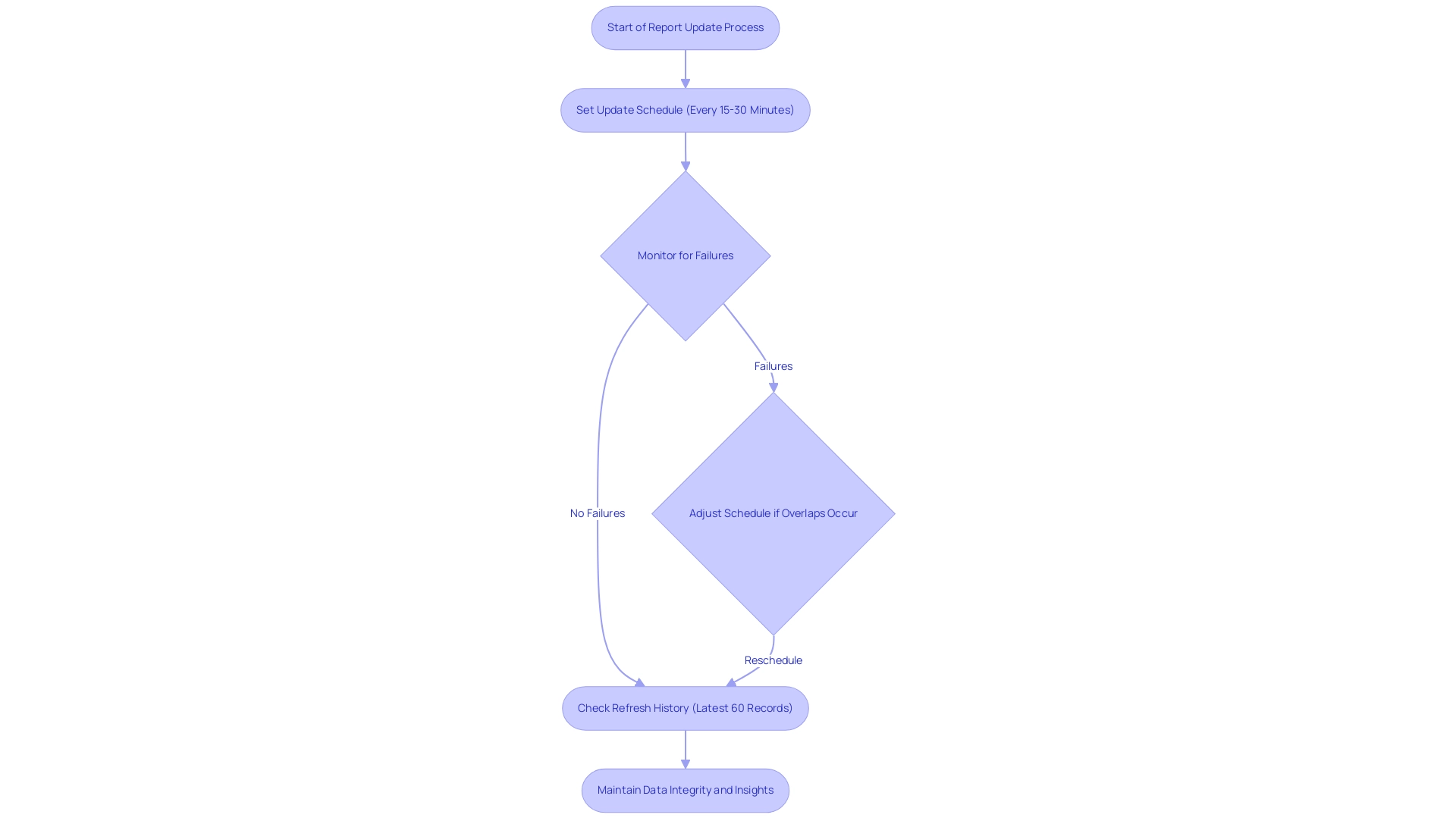
What Does ‘Include in Report Refresh’ Mean?
Include in Report Refresh Power BI’ is a pivotal feature that empowers users to dictate which sources are refreshed during a report update. By activating this option, users can ensure that all pertinent datasets receive updates together, facilitating a comprehensive view of the landscape. This becomes particularly advantageous for Directors of Operations Efficiency overseeing numerous information sources, as RPA can simplify this update process, improving operational effectiveness and enabling teams to concentrate on strategic initiatives.
Nonetheless, obstacles like information discrepancies and lengthy documentation processes can impede efficient decision-making. Usage metrics summaries generally update each day with new information, making it essential for operations leaders to remain in sync with the latest insights. If a document or dashboard is not shown, it likely hasn’t been utilized in over 90 days, highlighting the significance of keeping documents updated.
Denis Davydov notes that ‘to include in report refresh, it is used to maintain the old information; you will not extract the information from the source, and you can use it to join with another query if it is old information and you don’t keep fetching the information every time you perform a refresh.’ This capability not only enhances operational efficiency but also supports informed decision-making across the organization. Moreover, the integration of RPA solutions can help automate the report creation process, reducing errors and freeing up teams for more strategic work, ultimately driving business growth.
The case study on Admin Control Over Usage Metrics illustrates how BI administrators can enable or disable usage metrics, ensuring organizations manage data privacy and compliance while leveraging usage metrics for performance insights.
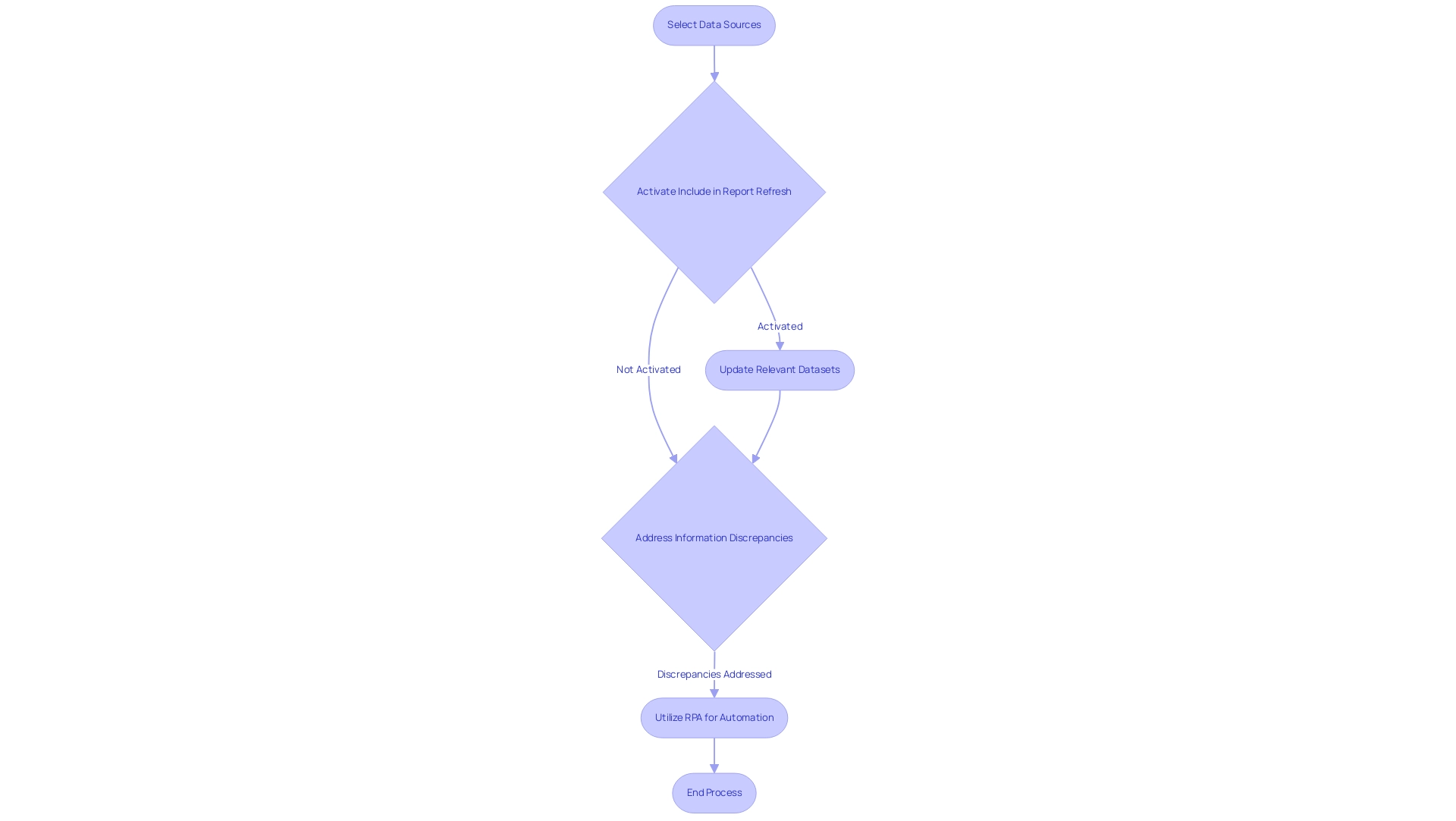
Step-by-Step Guide to Enable ‘Include in Report Refresh’
To effectively enable the ‘Include in Report Refresh’ feature in BI, follow these straightforward steps:
- Start your BI Desktop application and load the document you intend to modify. Click on the ‘Model’ icon located in the left sidebar to navigate to the ‘Model’ view.
- Choose the particular source you want to incorporate in the update by clicking on the relevant table or dataset. In the properties pane, locate the option to ‘include in report refresh power bi’ and check the box next to it to activate it. Save your changes and, if necessary, publish the document to Power BI Service to make it accessible. To confirm that the refresh operates as designed, go to the ‘Home’ tab and click on ‘Refresh’, making sure that the chosen information sources are updated appropriately.
By following these steps, you improve your reports’ precision and relevance, tackling common issues like inconsistencies and ensuring your insights are timely and actionable. This alignment with the latest information trends and insights supports informed decision-making that drives operational efficiency and business growth. Furthermore, think about checking the 12-minute tutorial on creating date tables in BI, which can further enhance your information management processes.
As Iason Prassides emphasizes, mastering features like DAX in Business Intelligence is crucial for customizing and optimizing key performance indicators (KPIs), especially when managing data refresh settings. Moreover, Douglas Rocha’s case study on utilizing statistical measures in Business Intelligence demonstrates how these concepts can be applied in real-world situations, emphasizing the significance of incorporating strong statistical analysis into your documents. To further enhance operational efficiency, consider leveraging RPA solutions like EMMA RPA and Automate, which can automate repetitive tasks and improve overall workflow, ensuring that your data-driven insights are not only accurate but also actionable.
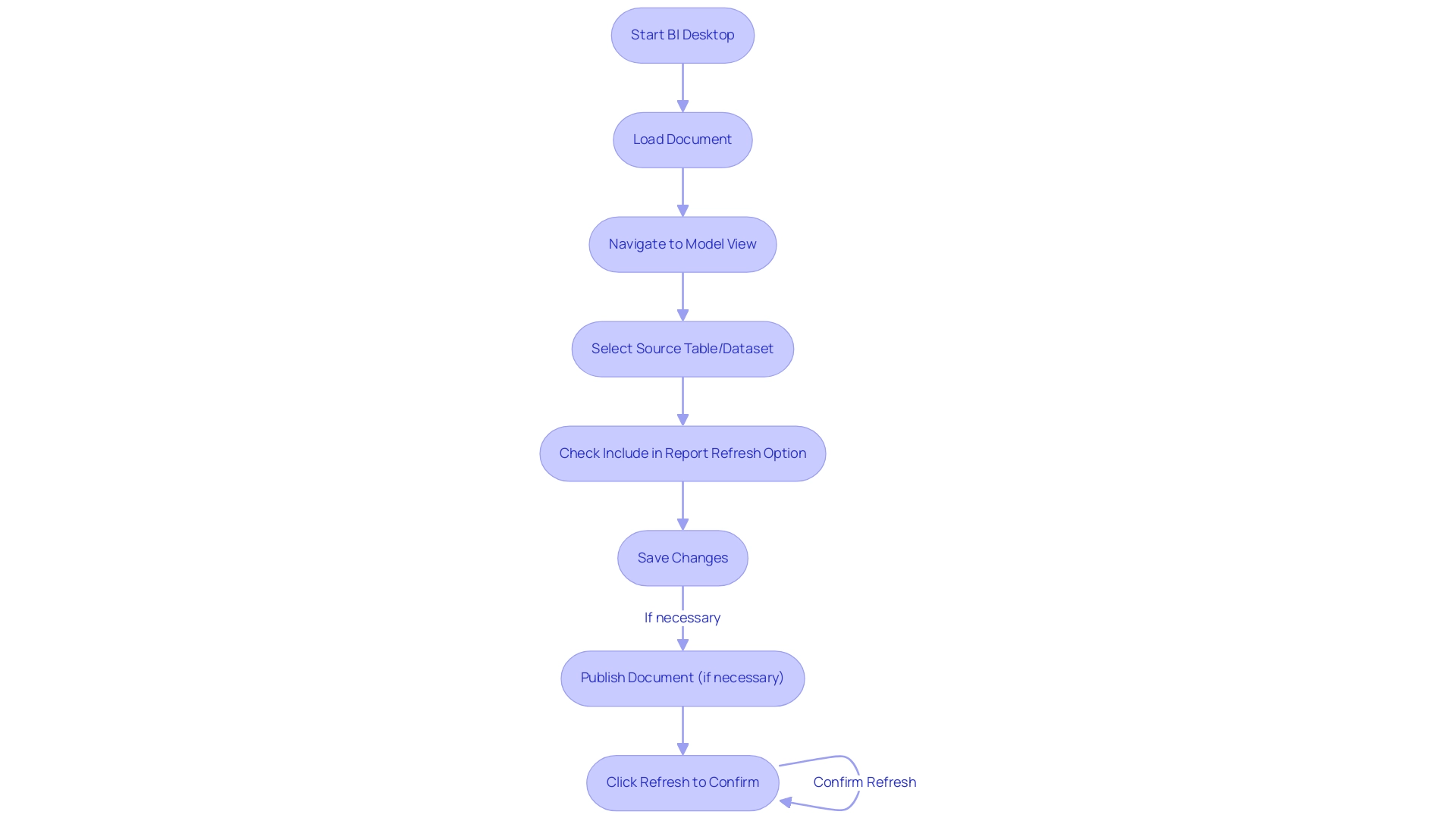
Troubleshooting Common Refresh Issues in Power BI
When working with BI, it is important to include in report refresh Power BI several common issues that users often encounter, as these can hinder efficiency and lead to wasted time and resources. Here are key challenges and effective solutions:
-
Source Connectivity Problems: Ensuring that all sources are accessible and credentials are correctly configured is crucial. If issues arise, check network connectivity and permissions, as Power BI may deem a semantic model inactive after just two months of inactivity. Maintaining regular user engagement with your dashboards is essential. By proactively managing access and connectivity, you can leverage Robotic Process Automation (RPA) to streamline these efforts and prevent interruptions in your information flow, thus mitigating the impact of manual, repetitive tasks.
-
Timeout Errors: Extended refresh times can lead to timeout errors. To address this, consider optimizing your queries or segmenting large datasets into smaller, more manageable chunks, enhancing performance and reliability. Customizing AI solutions can also help in improving these processes to better align with your business objectives.
-
Model Adjustments: Modifications to the underlying structure require corresponding updates to inquiry queries. It’s crucial to examine and modify information transformations to align with the updated model, ensuring consistency and precision in your documents, thus leveraging Business Intelligence for informed decision-making.
-
Insufficient Permissions: Lack of necessary permissions can obstruct access to information sources. If you encounter this issue, contact your administrator to secure the required access, enabling seamless data retrieval and allowing your team to focus on more strategic tasks.
-
Personal Data Gateway: For users without access to an enterprise gateway, deploying a personal data gateway can be a viable solution for managing data source configurations directly. While it has limitations compared to an enterprise gateway, it allows individual management of semantic models, helping to mitigate connectivity issues.
By identifying these common challenges and implementing the suggested troubleshooting strategies, you can effectively resolve refresh problems and include in report refresh Power BI to ensure that your reports remain accurate and up-to-date. Additionally, the difficulty in extracting meaningful insights from your BI dashboards can leave your business at a competitive disadvantage. Consider the insights of industry expert Jeff Shields, who emphasizes innovative approaches to data connectivity:
I wonder if you could ZIP them and read them into a dataflow from a OneDrive/SharePoint folder.
This emphasizes the potential for innovative solutions in optimizing your BI experience.
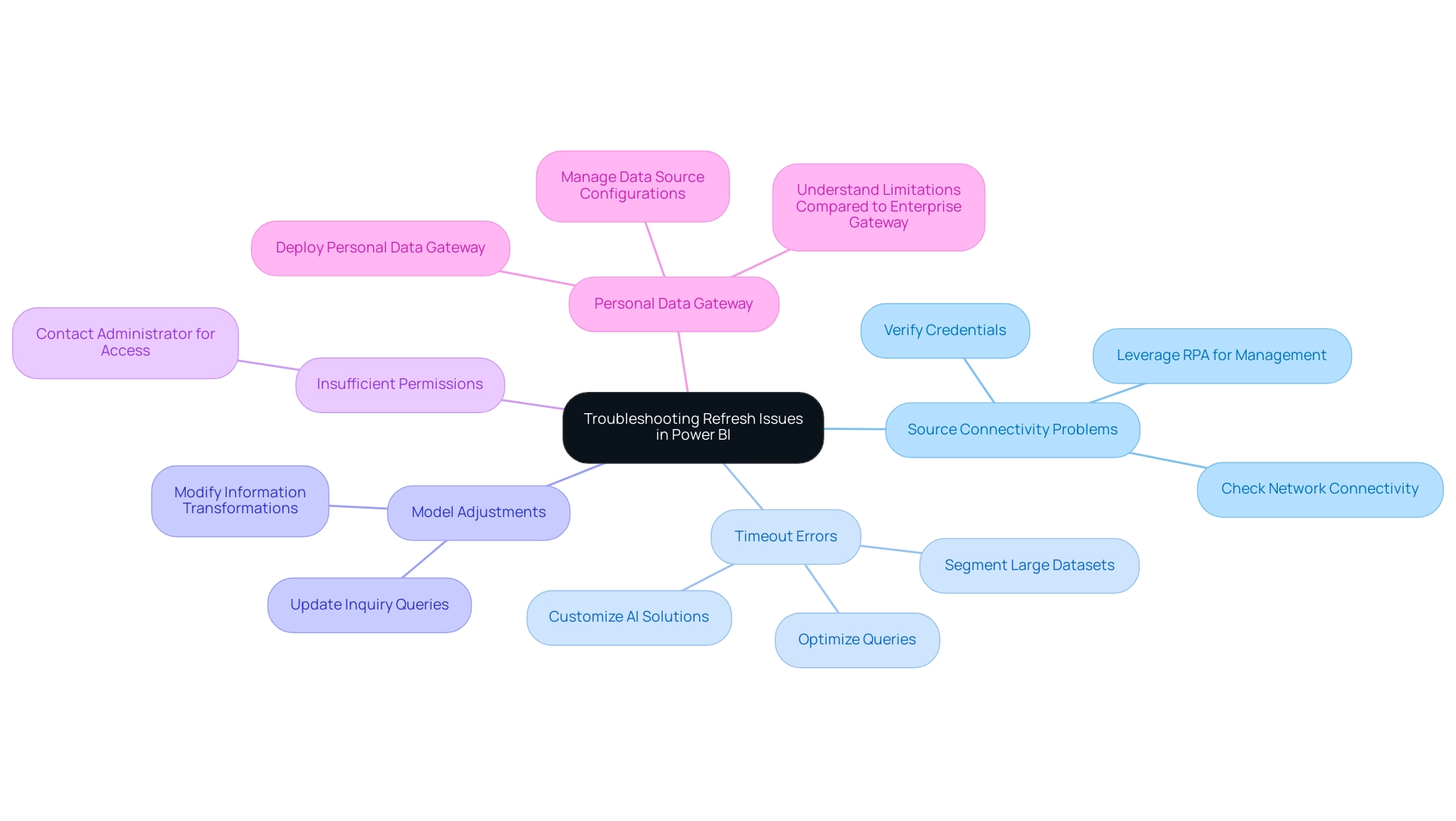
Best Practices for Efficient Report Refresh in Power BI
To optimize your refresh processes in Power BI, implementing the following best practices will significantly enhance efficiency while leveraging the power of Robotic Process Automation (RPA):
-
Schedule Refreshes: Conduct scheduled refreshes during off-peak hours to minimize performance impacts on users accessing documents. This approach not only improves performance but also enhances user experience, aligning with RPA’s goal of streamlining operations.
-
Limit Information Volume: Concentrate on including only the essential details in your reports. By utilizing filters to limit information where possible, you can dramatically decrease the quantity of content processed during refreshes, leading to quicker load times. For example, transforming the Matrix visual into a Table visual can decrease load time by around 15 seconds, showcasing the effect of visual optimization on update efficiency.
-
Optimize Queries: Carefully review your queries for efficiency. Leveraging query folding and avoiding complex transformations can prevent unnecessary delays in refresh times. As experts advise,
Before joining columns, always clean your information by trimming whitespace and ensuring the values are in a compatible format.
This practice alleviates issues that can arise during data processing and supports the data-driven insights necessary for business growth, while also minimizing errors that can stem from unoptimized queries. -
Monitor Performance: Regularly evaluate performance metrics in Power BI Service to identify any bottlenecks or areas that need enhancement. This proactive approach helps in maintaining optimal performance levels. For example, understanding row, query, and filter context in DAX can be challenging, but simplifying your explanations and using clear examples can demonstrate context behavior effectively, enhancing operational efficiency and reducing wasted resources.
-
Educate Users: Provide training to users on best practices for interacting with documents. This education aids in minimizing unnecessary update requests, ultimately sustaining overall system performance and ensuring that your organization can leverage insights effectively. By addressing common challenges associated with manual workflows, such as time-consuming report creation and data inconsistencies, you can further enhance the effectiveness of your reporting processes.
By adopting these strategies, you can significantly enhance the efficiency of your report refresh processes, ensuring that your Power BI reports remain timely and reliable while also integrating the principles of RPA and Business Intelligence, thus driving data-driven insights that contribute to your business growth and strategic objectives.
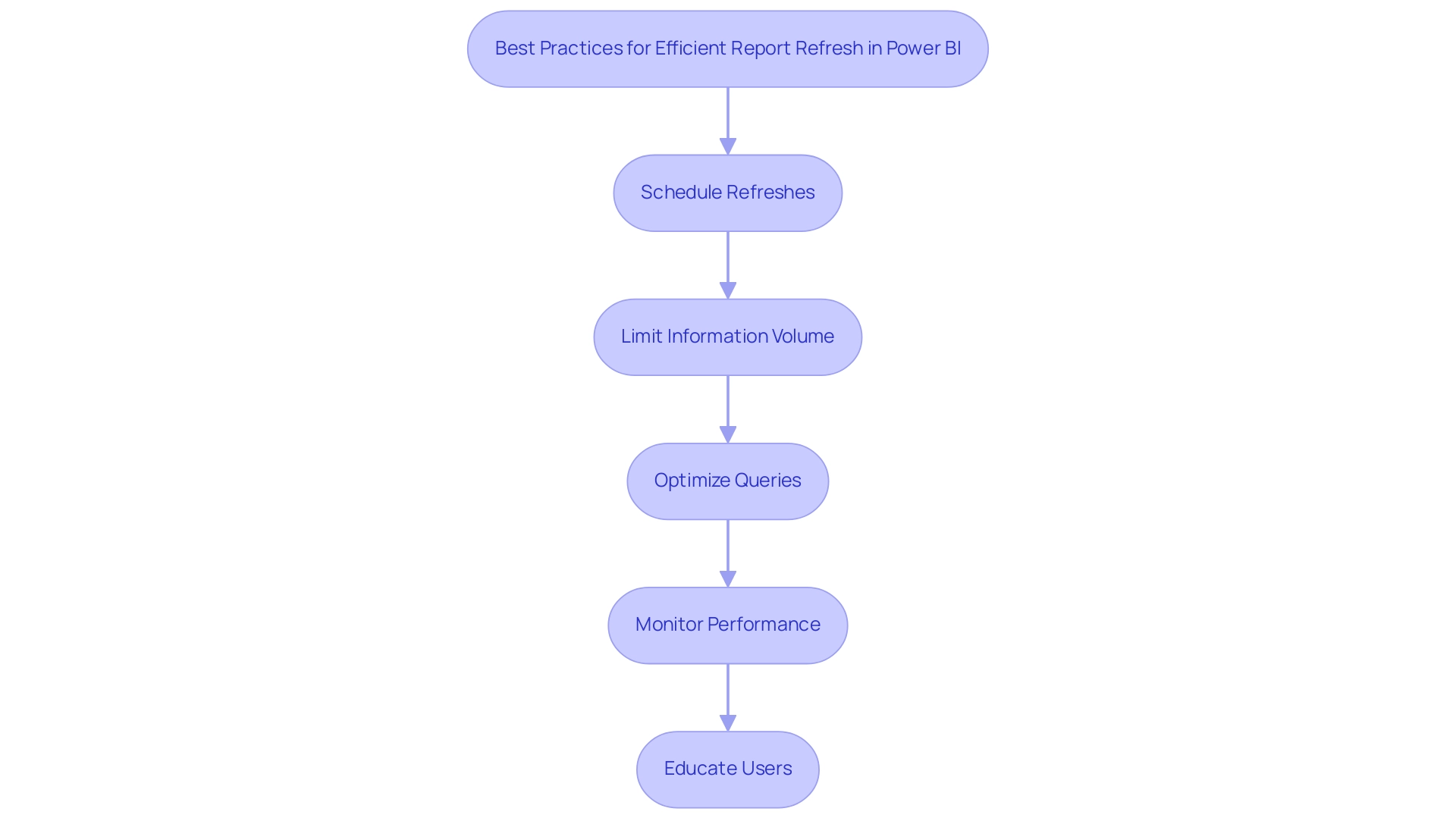
Conclusion
Maintaining up-to-date and accurate reports in Power BI is crucial for effective decision-making and operational efficiency. The article highlighted essential elements of the report refresh process, emphasizing the importance of scheduled updates and the utility of features like ‘Include in Report Refresh.’ By implementing a strategic approach to refresh scheduling, organizations can ensure that their reports reflect the latest data, thus enhancing the integrity of their insights.
Common challenges, such as data source connectivity issues and timeout errors, can disrupt the refresh process. However, the article provided practical solutions to troubleshoot these issues effectively. By prioritizing regular monitoring and optimizing data queries, teams can mitigate potential disruptions, ensuring that their data remains reliable and actionable.
Incorporating best practices, such as limiting data volume and educating users, can further streamline the report refresh process. These strategies not only improve performance but also empower teams to focus on strategic initiatives rather than administrative tasks. Ultimately, by leveraging the capabilities of Power BI and adopting a proactive approach to report refresh, organizations can drive growth through timely, data-driven insights that support informed decision-making and operational excellence.
